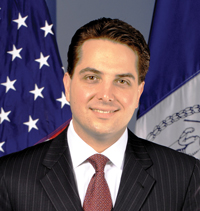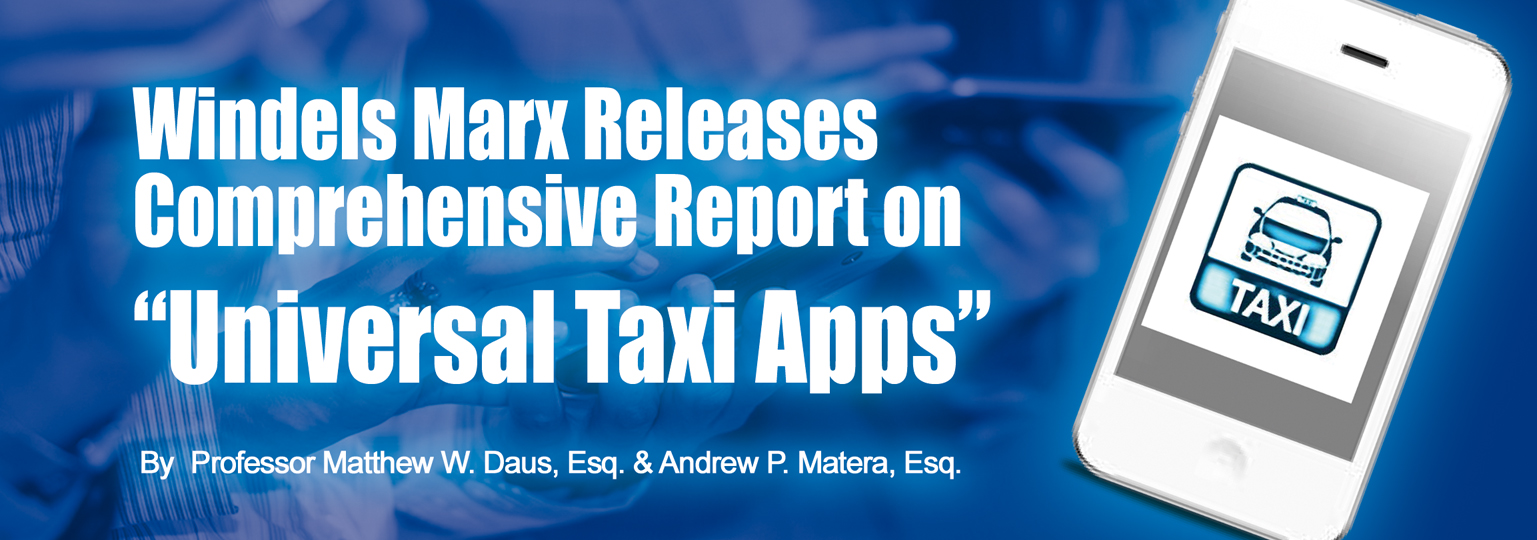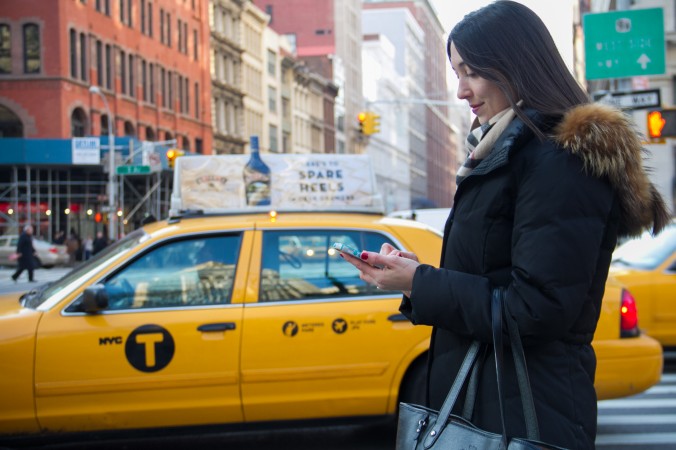 |
IN FOCUS |
|
by Matthew W. Daus, Esq. |
||
 |
||
Andrew P. Matera, Esq.1 |
||

One of the most promising technological applications for increasing the competitiveness of the taxi industry is the development of new mobile e-hail applications for all taxicabs as well as for- hire vehicles. These applications will attempt to "level the playing field" created by lopsided laws favoring Transportation Network Companies (TNCs).
There are a number of publicly initiated projects by transportation regulators, as well as private industry efforts underway, to institute so called "universal taxi apps." The law firm of Windels Marx Lane & Mittendorf, LLP, in a partial pro bono or volunteer engagement with the City of Montreal, conducted a comprehensive survey and analysis of all pending projects. The firm assisted the Montreal "Innovation Committee" with recommendations for policy making.
The full report can be accessed at:
http://www.windelsmarx.com/resources/documents/Study%20for%20a%20Centralized%20Application% 20for%20Taxis%20in%20Montreal%20-%20April%202016.pdf .
It will be showcased at the annual conference for the International Association of Transportation Regulators (IATR) in San Francisco (September 22-25, 2016) at a "universal taxi app workshop" for regulators.
The conference program can be viewed at:
http://files.ctctcdn.com/08b78404201/d153d70a-5da8-4c7d-a4d6- 01ac3cea2346.pdf?ver=1463756081000 .
To access the IATR website go to:
http://www.iatr.global/.
To register for the 2016 conference in San Francisco, go to:
http://www.iatr.memberlodge.org/event- 2215555.

An easy to use universal taxi e-hail application 2 gives customers in a particular jurisdiction access to, and the ability to electronically hail, the entire fleet of available taxis. This is accomplished through a single smartphone or mobile device application. It allows local taxi industries to more effectively compete with the user responsiveness of increasingly popular taxi alternatives like TNCs.
The success of any transportation service is ultimately dependent on how quickly, safely, affordably, and reliably a customer can arrive at their destination in comparison to other services or transportation modes. For TNCs and taxis, speed and reliability is dependent on the density of cars on the road. A service with thousands of available vehicles in a certain area will respond to a dispatch request faster, on average, than a service with a minimal number of vehicles.
Ultimately, the goal of the universal app is to require traditional taxicab companies, and sometimes TNCs, to jointly use an efficient centralized or "universal" electronic dispatch system. The system would be adapted to their operations in order to maintain high revenues for taxi drivers as well as fast and reliable service for consumers. The municipality or jurisdiction can also use this centralized taxi app to promote its own brand and for tourism purposes.
The methodological approach for our report, entitled: Study for a Centralized Application for Taxis in Montreal (the "Windels Universal App Study"), consists of a thorough analysis of primary data. The data was collected from regulators in various jurisdictions, the local incumbent industry, other new market entrants, the riding public, and other sectors. All contributors have a vested interest in the success of the for-hire industry as a whole. This assisted us in developing and evaluating policy options for the implementation of a universal e-hail application.
The study also discusses the current state of the market in Montreal and provides a comprehensive review of the different approaches undertaken, as well as the obstacles faced by various leading jurisdictions, in the process of implementing a universal application. This includes:
San Francisco, California; Chicago, Illinois; Los Angeles, California; Montgomery County, Maryland; New York City, New York; Tampa/Hillsborough County, Florida; Washington, D.C.; and several Canadian cities.
The Windels Universal App Study identified the top priorities for implementing a universal app in any city which includes ensuring that:
(a) riders find the app easy to use;
(b) the privacy of users is protected; and
(c) local taxicab companies and independent taxi drivers are able to efficiently adapt their operations to comport with the centralized (or "universal") electronic dispatch system while maintaining high revenues.
Some of the key universal app features include:
(i) superior hi-tech functionality and service;
(ii) ability to handle on-demand or prearranged trip requests;
(iii) pick-up location input options (i.e. physical address, landmark, utilization of GPS from a customer's phone);
(iv) ability to request specific vehicles, such as accessible taxis;
(v) commitment to passenger safety, convenience and satisfaction, including an ability for customers to provide additional specific instructions and notes to drivers, and to display options such as driver's name/driver's picture/vehicle number/vehicle location at time of request/route to pick-up location;
(vi) provision of customer "Profile" section for each customer, including contact information;
(vii) provision of "Support" option for customers to submit compliments or complaints;
(viii) passenger/driver communications options, including ability for passengers to send text messages to driver and provision of anonymous call system;
(ix) provision of e-payment complying with industry data security standards; and
(x) provision of "Driver Facing Dispatch Technology" application with multiple functions.
The Windels Universal App Study discusses several approach options for consideration based upon a review of other jurisdictions, including the following:

As with all of our consulting reports conducted for specific jurisdictions, we also provide a specifically tailored regulatory approach recommendation for how Montreal could best implement a universal application given the market factors and variables that are unique to the city. Our recommendation, given the state of the market in Montreal, is that the best approach would be to adopt an open shared platform with a government application allowing competitive commercial applications to operate in the City as well.
Each individual jurisdiction has its own unique characteristics, evolutionary stage in terms of technology, and various political, socio-economic, legal and other dynamics. They do not call for a "one-size-fits-all" approach to the implementation of a "universal taxi application" solution.
The various regulatory agencies and private entities which have begun engaging in cutting edge regulatory innovation, and exploring new ideas, should continue to be encouraged, tracked and monitored. Montreal is benefitting from its own exchange of ideas, regulatory actions and leadership, as well as those of other regulatory agencies identified in our report. 3
Technological initiatives such as a universal taxicab e-hail app could potentially be used to carve out retail niches. For example, taxicabs using a universal e-hail application in a particular jurisdiction could be focused to provide service in underserved portions of the market. At the same time, TNCs and surge pricing are dominating peak hours and high-end customers.
This could lead to the refocusing of taxicabs to serve specific niche areas in addition to the broader general consumer market and potentially lead to the creation of new consumer bases. This includes the receipt of public paratransit subsidies to use wheelchair accessible taxicabs, on demand, to deliver app-based service to passengers with disabilities.
It remains to be seen how many of the jurisdictions discussed will move forward on the universal application issue. We are confident Montreal and the other jurisdictions discussed will be closely watched by other regulators in the United States, Canada and beyond.
1 Andrew Matera, an attorney with the law firm of Windels Marx Lane &amq; Mittendorf, LLP, assisted in the preparation of this article, as well as the report on universal apps. Also, special thanks go to the following staff from Windels Marx, for this partial pro bono or volunteer effort for the City of Montreal, as well as for regulators everywhere who can learn from the analysis and recommendations of this comprehensive report: Sharon Klein, Salma Mallah and Jason Mischel.
2 While the definition of a "universal taxi app" is an evolving concept, and it is not yet capable of a precise 'term-of-art' definition, for the purpose of our report, reference to a "universal app" is defined as: "a public and/or private sector technology solution to allow for multiple or all taxicabs (and possibly other for-hire vehicle sub-modes or services), to be placed on one or more smartphone applications (for one or more government branded or private apps), to consolidate dispatch functions to allow for a more efficient delivery of the nearest taxicab or for-hire vehicle to consumers, with the goal of encouraging competition, consumer choice, safety and to allow for the collection, use and analysis of data, development of open data and cross-dispatching integrated platforms, and credit/debit card processing, with the overriding goal of leveling the playing field as an alternative to TNC market dominance." This definition is based upon an all-encompassing review of the various regulatory approaches included in the report, with its language evolving over time as various projects reach fruition and are further analyzed as to their levels of success.
3 At this nascent stage, it is too early to identify best or accepted regulatory practices that should be ubiquitously applied; and the approach chosen for Montreal does not, in any way, support or favor any other jurisdictions, or result in any tacit or overt opinion that the approaches of other cities are not appropriate.